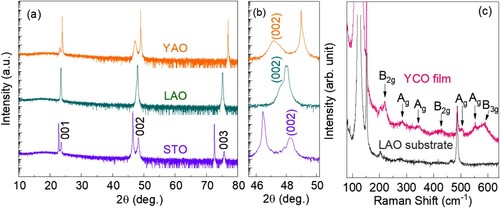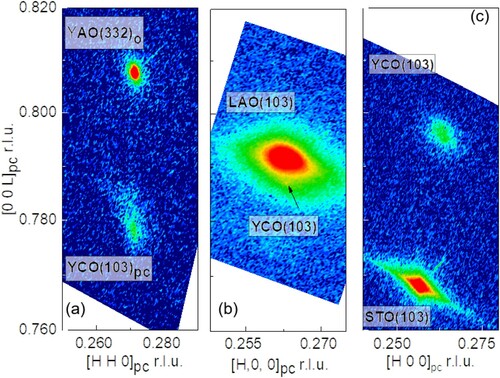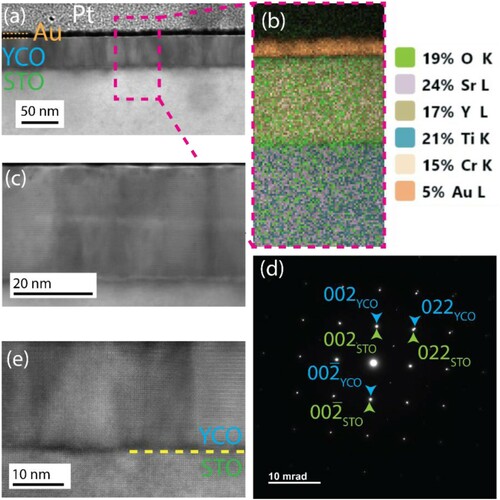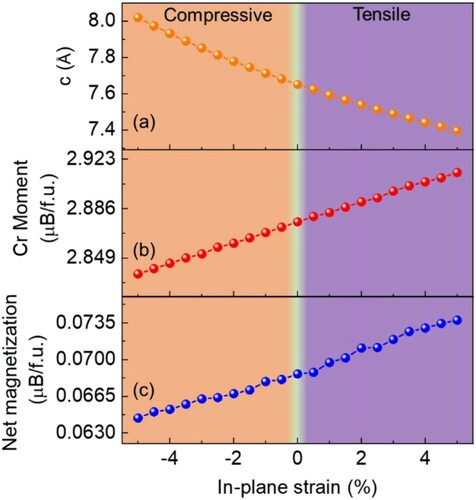 ?Mathematical formulae have been encoded as MathML and are displayed in this HTML version using MathJax in order to improve their display. Uncheck the box to turn MathJax off. This feature requires Javascript. Click on a formula to zoom.
?Mathematical formulae have been encoded as MathML and are displayed in this HTML version using MathJax in order to improve their display. Uncheck the box to turn MathJax off. This feature requires Javascript. Click on a formula to zoom.Abstract
The influence of lattice strain on magnetism is studied for perovskite rare-earth chromite, YCrO3 (YCO) thin films. A combined theoretical and experimental approach is used to demonstrate the correlation between lattice-strain and magnetic properties of YCO films. The first-principles calculations reveal that the local Cr magnetic moments and the out-of-plane magnetization linearly increase with changing the in-plane lattice strain from compressive to tensile. The experimental results agree with the theory findings showing a strong dependence of magnetization on epitaxial strain in YCO films. These results unveil the lattice-strain-controlled functionalities on perovskite rare-earth chromites and related material systems.
GRAPHICAL ABSTRACT

IMPACT STATEMENT
This work demonstrates the correlation between lattice and spin degree of freedoms in rare-earth chromites, which establishes a way to tailor functionalities in magneto-electric device applications.
Introduction
Perovskite rare-earth orthochromites (RCrO3, R = rare-earth metals) have recently attracted tremendous interest as they exhibit magnetoelectric multiferroicity that can show great promise for low-energy spintronics, magnetocaloric, magnetic sensors and memory devices [Citation1–7]. The two ferroic orders, ferroelectricity at higher temperature and magnetism at relatively lower temperature, are observed in RCrO3 [Citation8–10]. Despite its centrosymmetric structure (Pbnm, GdFeO3-type), the origin of ferroelectricity in RCrO3 is due to the displacement of Cr3+ ions from the center of the Cr-sublattice and the weak ferromagnetism results from the G-type canted antiferromagnetism (CAFM) of Cr3+ spins [Citation8,Citation11–13]. Interestingly, RCrO3 materials exhibit a broad spectrum of rich magnetic properties such as spin reorientation transition, spin flipping, exchange bias, magnetization reversal, and anisotropic magnetostriction [Citation14–19].
Tuning magnetic, optical and electronic properties of RCrO3 under different stimuli such as temperature, chemical doping, epitaxial strain, electric field, and hydrostatic pressure have revealed novel and fundamental physical phenomena [Citation12,Citation20–26]. A strong order parameter coupling can be observed in terms of changing net magnetic moment, magnetic ordering temperature, and optical band-gap through the change of internal strain in the RCrO3 lattice [Citation20–25,Citation27]. However, these studies are limited to either bulk ceramics or theoretical predictions. A few experimental studies have reported the effect of lattice-distortions on magnetic anisotropy, magnetic transition temperature, and dielectric properties in thin-film RCrO3 [Citation8,Citation25,Citation28,Citation29]. Most reported films are polycrystalline and the correlation between epitaxial strain and magnetism in RCrO3 films is not well-established.
In this work, we perform experimental and theoretical studies to reveal the effect of strain on the magnetic properties of YCrO3 (YCO) epitaxial films. YCO is a member of the RCrO3 family and an insulating antiferromagnetic system, which shows intriguing functional properties [Citation30–33]. YCO shows the onset of CAFM transition at 140 K resulting in weak ferromagnetism at low temperature [Citation34,Citation35]. We investigate the magnetic behavior of differently strained YCO thin films, grown on (110)O [O→orthorhombic] YAlO3 (YAO), and (001) LaAlO3 (LAO) and (001) SrTiO3 (STO) substrates. A direct correlation between lattice-strain and magnetic behavior in YCO epitaxial thin films is demonstrated.
Experimental details
A stoichiometric polycrystalline ceramic target of YCrO3 (YCO) was synthesized using a conventional solid-state reaction method [Citation36]. YCO films were deposited on (110)O YAO (equivalent to (001) pseudo cubic direction), (001) LAO and (001) STO substrates, using pulsed laser deposition (PLD). The target was ablated by a KrF excimer laser (λ = 248 nm) operating at a repetition rate of 4 Hz with a laser fluence of 1.25 J/cm2. The detailed growth conditions were described elsewhere [Citation25]. Panalytical X’Pert Pro four-circle high-resolution X-ray diffractometer with Cu Kα1 radiation was employed for the X-ray diffraction (XRD) characterization of the crystal structure and strain of the films. The film's thickness, interface and microstructure were characterized by high-resolution transmission electron microscopy (HRTEM). Magnetization measurements as a function of applied magnetic field (M–H loops) were measured in a physical property measurement system (PPMS, Quanum Design) with a vibrating sample magnetometer (VSM) option. M–H hysteresis loops were collected for the complete cycle of magnetic field +7 kOe ≤ H≤ −7 kOe along the out-of-plane direction of the samples at 10 K. Raman spectroscopic measurements were conducted in backscattering/reflection mode using a 532.3 nm excitation (Oxxius LCX-532S-100, 100 mW continuous wave single longitudinal mode diode pumped solid state laser) in a Horiba LabRAM HR Evolution microscope fitted with volume Bragg gratings. Intensity was calibrated using a VIS-Halogen light source (NIST test no. 685/289682-17), and spectral calibration was performed using the 1332.5 cm−1 peak of a synthetic Type IIa diamond [Citation37]. The instrument was configured using a 50 µm confocal hole, a 2400 gr/mm grating, and a 100× 0.90 numerical aperture objective.
Calculation methods
The quantum mechanical computations were performed within the density functional theory (DFT) approach using the Vienna Ab initio Simulation Package (VASP) [Citation38,Citation39]. A plane-wave basis set and the generalized gradient approximation (GGA) [Citation40] of Perdew–Burke–Ernzerhof (PBE) [Citation41] with projector augmented wave (PAW) method [Citation42] were used to obtain the relaxed structure and magnetic properties of YCO. A plane wave cut-off energy of 520 eV was used for the plane-wave basis set and a Γ-centered Monkhorst–Pack k-point mesh [Citation43] of 6 × 6 × 5 was used for the Brillouin zone sampling of the 20-atom orthorhombic cell (Pbnm space group) which can be viewed as a √2 × √2 × 2 multiple of the prototypical five-atom pseudo-cubic perovskite unit cell. The O 2s and 2p, the Cr 3p, 4s, 3d, and Y 4s, 4p, 4d, and 5s electrons were included in the valence states. A 0.05 eV Gaussian smearing was applied to band occupancies near the Fermi level, and total energies were extrapolated back to 0 K. Spin–orbit coupling, with non-collinear magnetic states allowed, was explicitly considered in the calculations and a ‘Hubbard U’ correction (with Dudarev's formulation; J = 0 eV and U = 3.7) [Citation44] was employed to correctly represent the localized electronic states of Cr's 3d electrons [Citation45]. To obtain a geometry optimized equilibrium structure, starting with a G-type antiferromagnetic configuration all atomic positions, as well as the three lattice parameters were fully relaxed using the conjugate gradient method until all the Hellmann–Feynman forces and the stress component were less than 0.005 eV/Å and 1.0 × 10−3 GPa, respectively.
Results and discussion
Bulk YCO has the orthorhombic structure with the lattice parameters a = 5.255 Å, b = 5.520 Å and c = 7.536 Å, where the corresponding pseudocubic unit-cell structure yields apc = 3.786 Å [Citation8,Citation46]. YCO films on YAO, LAO and STO substrates have in-plane (IP) lattice mismatches of −2.05%, 0.05% and 3.05% respectively.
Figures (a) and 1(b) show the XRD full range θ–2θ scan and the local scans around (002) peaks of the films on YAO, LAO and STO, respectively. Only 00l reflections of the YCO films are observed from the θ–2θ scans, indicating that the films are epitaxial and phase pure. The thickness of the films measured from TEM are 44 nm on YAO, 42 nm on LAO and 46 nm on STO substrates. Figure (c) shows the room temperature Raman spectroscopy of YCO/LAO and bare LAO substrate in the 100–600 cm−1 spectral window. The YCO film's spectrum show up to seven Raman modes of Ag, B2g and B3g symmetries, which are consistent with the phonon modes observed in bulk ceramic and single-crystal YCO [Citation36,Citation47]. Therefore, the XRD and Raman measurements confirm the desired structure and lattice symmetry of YCO epitaxial films.
Figure 1. Room-temperature XRD θ−2θ scans and Raman spectrum of YCO thin films. (a) XRD θ–2θ scans for the YCO films deposited on (110)O YAO, (001) LAO and (001) STO substrates. (b) An enlarged view of θ–2θ scans around the (002) YCO film peak. (c) Room temperature Raman spectrum of the YCO film grown on LAO substrate, including the spectrum from the bare LAO substrate.

To investigate the strain states of the films, X-ray reciprocal space mappings (RSMs) were performed around the orthorhombic YAO (332), LAO (103), and STO (103) reflections, which corresponds to the pseudocubic (103) reflection of the YCO. The 44 nm YCO film on YAO is slightly relaxed due to the higher compressive misfit of −2.05%, as shown in Figure (a). The RSM of 42 nm YCO film on LAO measured around the (103) reflection indicates that the film is fully strained due to the very small lattice misfit strain of 0.05%, as shown in Figure (b). The RSM of 46 nm YCO film on STO around the (103) reflection indicates that the YCO film is relaxed due to a large misfit of 3.05% (Figure c). The psuedocubic IP lattice parameters on YAO, LAO, and STO substrates are calculated to be = 3.726, 3.786 and 3.808 Å, respectively, from RSM. The IP biaxial tensile strains calculated using ϵxx = (
)/
are −1.58%, 0.00%, and 0.58% for YAO, LAO and STO substrates. The out-of-plane (OOP) lattice parameters are
= 3.847, 3.790 and 3.762 Å and the strains calculated using ϵzz = (
)/
are 1.61%, 0.11% and −0.63% for YAO, LAO and STO, respectively. The films’ tetragonality (
) on YAO, LAO, and STO are 1.03, 1.00 and 0.99, respectively, which decreases while going from compressive to tensile strain.
Figure 2. RSMs of YCO films on different substrates. (a) RSM around (332) orthorhombic reflection on YAO and (103) pseudocubic reflection of YCO film. RSMs around (103) reflections of (b) YCO/LAO, and (c) YCO/STO films.

The YCO/STO film microstructure and interface quality were investigated by HRTEM. A cross-section view of the film on STO shows crystallinity with an approximately uniform interface without any obvious defects (Figure a). As shown in Figure (b), the energy-dispersive X-ray spectroscopy (XEDS) is demonstrated for local chemical fidelity of the film on an STO substrate. The XEDS signal from oxygen is distributed from film to substrate, across the interface, as both contain oxygen. Figure (c) shows the HRTEM image of the interface without any obvious defects. To check the crystallinity and epitaxial quality of the film, the selected area electron diffraction (SAED) on YCO/STO was also performed and shown in Figure (d). The clear and distinguished diffraction spots confirm the epitaxial growth of YCO film on STO, which is consistent with the XRD measurements. The magnified cross-sectional view of the film-substrate interface in high-resolution, shown in Figure (e), confirms the single crystallinity of the film. The contrast at the interface is sharp and distinguishable between film and substrate.
Figure 3. TEM images of YCO on STO substrate. (a) The cross-sectional TEM on the sample shows the abrupt film-substrate interface. (b) XEDS spatial maps of O, Sr, Y, Ti, and Cr near the film-substrate interface. (c) HR-TEM image around the film-surface interface (d) SAED pattern of YCO on cubic STO substrate. (e) The enlarged HRTEM view of the interface.

Theoretical investigations were carried out to understand the effect of lattice strain on the magnetic properties of YCO. Following Bertaut's notation, which denotes both the type of magnetic ordering and the direction of the corresponding magnetic order parameter, the modeled magnetic ordering for the relaxed YCO can be characterized as the Γ4 (Ga, Ab, Fc) spin configurations exhibiting weak ferromagnetic moments along the c direction while local magnetic moments on Cr atoms are predominantly aligned along the a direction in a G-type AFM configuration [Citation3]. To understand the effect of lattice strain, epitaxially strained supercells with IP misfit strain varying systematically from a 5% compressive to a 5% tensile strain, in steps of 0.5% were considered. To model the strained supercells, the a and b lattice parameters were constrained to the respective strained values relative to the relaxed case, while the c lattice parameters and all the internal coordinates were allowed to relax. Spin–orbit coupling was explicitly considered in all the computations.
Figure showcases our computational results for the total IP Cr magnetic moments along the a-direction in a G-type antiferromagnetic configuration, net OOP magnetic moments, and the OOP lattice parameters as a function of IP lattice strain ranging from 5% compressive to 5% tensile strain. In Figure (a), the lattice constant along the c-axis decreases going from compressive to tensile strain, which is consistent with the XRD results. Figures (b) and 4(c) show that both the local magnetic moments on the Cr atoms as well as the net magnetization perpendicular to film's plane linearly increase with the IP lattice strain systematically changing from a compressive to a tensile strain.
Figure 4. DFT calculations on variation of (a) OOP lattice parameters, (b) Cr magnetic moment and (c) net remanent magnetization with the IP strain, ranging from compressive to tensile.

The experimental studies are performed to further investigate the theoretical findings. The low-temperature magnetic measurements are performed to examine the M–H hysteresis by applying magnetic field along the OOP direction to the YCO films up to ±7 kOe at 10 K. The M–H loops for the variably strained films are shown in Figure . From Figure (a–c), it is observed that the net magnetization increases while changing IP strain from compressive to tensile. The remanent magnetization perpendicular to the plane of YCO films is increased while going from compressive to tensile strain (Figure d), which is consistent with the theoretical results presented in Figure (c). The presence of such non-zero remnant magnetizations shows that the YCO films exhibit a weak ferromagnetic order. The change in lattice parameters and OOP remanent magnetization with lattice-strain is summarized in Table . These results indicate that the lattice strain has a strong influence on the magnetic properties, which indicates a strong correlation between lattice and spin orders in YCO.
Figure 5. Zero field cooled OOP M-H hysteresis loops of YCO on (a) YAO, (b) LAO and (c) STO substrates measured at 10 K. (d) OOP remanent magnetization increases while changing the strain from compressive (YAO) to tensile (STO).

Table 1. Summary of the lattice parameters, strain states and OOP remanent magnetization of YCO films on different substrates.
The experimental results are consistent with the DFT findings on structural and magnetic behaviors of YCO. Based on previous DFT results on SmCrO3 [Citation28], the observation of strain tuned magnetism in YCO can be explained if the modification of the Cr–Cr superexchange interaction is of central importance in driving the strain tuning of magnetization. Specifically, the strain-induced magnetic behavior can be explained from superexchange interaction of Cr–O–Cr, which is related to the changes in bond angles of Cr–O–Cr due to the biaxial strain. When the film is subjected to compressive strain, Cr–O–Cr bond angle decreases along the in-plane direction and increases along the OOP direction, whereas the opposite effect is observed for tensile strain [Citation48]. This change in bond angle and enhanced orbital overlap along the IP direction could be the driver of the higher saturation moment. While this observation based on prior computational studies is also in line with our calculations, experimental validation of this would require further measurements aimed at quantifying octahedral rotations and bond lengths.
Conclusion
In summary, a combined experimental and theoretical approach is used to demonstrate the direct correlation between lattice-strain and magnetic properties of YCO films. Theoretical calculations show that the local magnetic moments on the Cr atoms as well as the net magnetization perpendicular to film's plane linearly increase with the in-plane lattice strain. Field-dependent magnetometry experiments further confirm that the magnetic properties are strongly dependent on substrate-induced lattice strain in YCO. The ability to achieve strain-controlled magnetism can provide insights on both the fundamental understanding of physical properties and the utilization of rare-earth orthochromites for functional applications.
Acknowledgments
The work at Los Alamos National Laboratory (LANL) was supported by the NNSA's Laboratory Directed Research and Development Program, and was performed, in part, at the Center for Integrated Nanotechnologies, an Office of Science User Facility operated for the U.S. Department of Energy Office of Science. Los Alamos National Laboratory, an affirmative action equal opportunity employer, is managed by Triad National Security, LLC for the U.S. Department of Energy's NNSA, under contract 89233218CNA000001. B. P. acknowledges support from the New Mexico Consortium (subcontract number; 028366). Y. S. acknowledges the support from the G. T. Seaborg Postdoctoral Fellowship at LANL. B. D. acknowledges the LANL Director's Postdoctoral Fellowship. G.P. was supported by the Los Alamos National Laboratory's LDRD program's Directed Research (DR) project number 20200104DR. Computational support for this work was provided by Los Alamos National Laboratory's high-performance computing clusters.
Disclosure statement
No potential conflict of interest was reported by the author(s).
Data availability
The data that support the findings of this study are available from the corresponding author upon reasonable request.
Additional information
Funding
References
- Serrao CR, Kundu AK, Krupanidhi SB, et al. Biferroic YCrO3. Phys Rev B. 2005;72:220101.
- Shi J, Seehra MS, Dang Y, et al. Comparison of the dielectric and magnetocaloric properties of bulk and film of GdFe0.5Cr0.5O3. J Appl Phys. 2021;129:243904.
- Rajeswaran B, Khomskii DI, Zvezdin AK, et al. Field-induced polar order at the néel temperature of chromium in rare-earth orthochromites: interplay of rare-earth and Cr magnetism. Phys Rev B. 2012;86:214409.
- Preethi Meher KRS, Wahl A, Maignan A, et al. Observation of electric polarization reversal and magnetodielectric effect in orthochromites: A comparison between LuCrO3 and ErCrO3. Phys Rev B. 2014;89:144401.
- Cheong S-W, Mostovoy M. Multiferroics: a magnetic twist for ferroelectricity. Nat Mater. 2007;6:13–20.
- Ramesh R, Spaldin NA. Multiferroics: progress and prospects in thin films. Nanosci Technol Collect Rev Nature J. 2010: 20–28.
- Spaldin NA, Fiebig M. The renaissance of magnetoelectric multiferroics. Science. 2005;309:391–392.
- Ray N, Waghmare UV. Coupling between magnetic ordering and structural instabilities in perovskite biferroics: a first-principles study. Phys Rev B. 2008;77:134112.
- Cao Y, Cao S, Ren W, et al. Magnetization switching of rare earth orthochromite CeCrO3. Appl Phys Lett. 2014;104:232405.
- Sahu JR, Serrao CR, Ray N, et al. Rare earth chromites: a new family of multiferroics. J Mater Chem. 2007;17:42–44.
- Ramesha K, Llobet A, Proffen T, et al. Observation of local non-centrosymmetry in weakly biferroic YCrO3. J Phys: Condens Matter. 2007;19:102202.
- Dalal B, Sarkar B, Rayaprol S, et al. Unveiling ferrimagnetic ground state, anomalous behavior of the exchange-bias field around spin reorientation, and magnetoelectric coupling in YbC r1–xFeXO3 (0.1 ≤X≤ 0.6). Phys Rev B. 2020;101:144418.
- Saha R, Sundaresan A, Rao CNR. Novel features of multiferroic and magnetoelectric ferrites and chromites exhibiting magnetically driven ferroelectricity. Mater Horiz. 2014;1:20–31.
- Durán A, Escamilla R, Escudero R, et al. Reversal magnetization, spin reorientation, and exchange bias in YCrO3 doped with praseodymium. Phys Rev Mater. 2018;2:014409.
- Fita I, Puzniak R, Wisniewski A, et al. Spin switching and unusual exchange bias in the single-crystalline GdCrO3 compensated ferrimagnet. Phys Rev B. 2019;100:144426.
- Su Y, Zhang J, Feng Z, et al. Magnetization reversal and Yb3+/Cr3+ spin ordering at low temperature for perovskite YbCrO3 chromites. J Appl Phys. 2010;108:013905.
- Kumar A, Yusuf SM. The phenomenon of negative magnetization and its implications. Phys Rep. 2015;556:1–34.
- Oliveira G, Teixeira R, Moreira R, et al. Local inhomogeneous state in multiferroic SmCrO3. Sci Rep. 2020;10:1–12.
- Gupta P, Bhargava R, Poddar P. Colossal increase in negative magnetization, exchange bias and coercivity in samarium chromite due to a strong coupling between Sm3+–Cr3+ spins sublattices. J Phys D: Appl Phys. 2014;48:025004.
- Zhou J-S, Alonso JA, Muoñz A, et al. Magnetic structure of LaCrO3 perovskite under high pressure from In situ neutron diffraction. Phys Rev Lett. 2011;106:057201.
- Bolletta JP, Pomiro F, Sánchez RD, et al. Spin reorientation and metamagnetic transitions in RFe0.5Cr0.5O3 perovskites (R = Tb, Dy, Ho, Er). Phys Rev B. 2018;98:134417.
- Taheri M, Razavi FS, Yamani Z, et al. Structural, magnetic, and thermal properties of Ce1−×EuXCrO3 orthochromite solid solutions. Phys Rev B. 2019;99:054411.
- Fu D, Liu Y, Zhang H, et al. The evolution of magnetization switching of LuCrO3 by the effect of Mn doping. J Alloys Compd. 2018;735:1052–1062.
- Mall AK, Garg A, Gupta R. Modifications of the structure and magnetic properties of ceramic YCrO3 with Fe/Ni doping. Mater Res Express. 2017;4:076104.
- Sharma Y, Skoropata E, Paudel B, et al. Epitaxial stabilization of single-crystal multiferroic YCrO3 thin films. Nanomaterials. 2020;10:2085.
- Zvezdin A, Gareeva Z.Multiferroic order parameters in rhombic antiferromagnets. RCrO3. arXiv preprint arXiv:201205659. 2020.
- Sharma Y, Paudel B, Lee J, et al. Tuning magnetic and optical properties through strain in epitaxial LaCrO3 thin films. Appl Phys Lett. 2021;119:071902.
- Zhao HJ, Ren W, Chen XM, et al. Effect of chemical pressure, misfit strain and hydrostatic pressure on structural and magnetic behaviors of rare-earth orthochromates. J Phys Condens Matter. 2013;25:385604.
- McDannald A, Vijayan S, Shi J, et al. Magnetic and tunable dielectric properties of DyCrO3 thin films. J Mater Sci. 2019;54:8984–8994.
- Goodenough JB. Electronic and ionic transport properties and other physical aspects of perovskites. Rep Prog Phys. 2004;67:1915–1993.
- Subba Rao GV, Wanklyn BM, Rao CNR. Electrical transport in rare earth ortho-chromites, -manganites and -ferrites. J Phys Chem Solids. 1971;32:345–358.
- Sharma Y, Misra P, Katiyar RS. Unipolar resistive switching behavior of amorphous YCrO3 films for nonvolatile memory applications. J Appl Phys. 2014;116:084505.
- Gervacio-Arciniega JJ, Murillo-Bracamontes E, Contreras O, et al. Multiferroic YCrO3 thin films: structural, ferroelectric and magnetic properties. Appl Surf Sci. 2018;427:635–639.
- Serrao CR, Kundu AK, Krupanidhi SB, et al. Biferroic YCrO3. Phys Rev B. 2005;72:220101.
- Ray N, Waghmare UV. Coupling between magnetic ordering and structural instabilities in perovskite biferroics: a first-principles study. Phys Rev B. 2008;77:134112.
- Sharma Y, Sahoo S, Perez W, et al. Phonons and magnetic excitation correlations in weak ferromagnetic YCrO3. J Appl Phys. 2014;115:183907.
- Solin SA, Ramdas AK. Raman spectrum of diamond. Phys Rev B. 1970;1:1687–1698.
- Kresse G, Furthmüller J. Efficient iterative schemes for ab initio total-energy calculations using a plane-wave basis set. Phys Rev B. 1996;54:11169.
- Kresse G, Joubert D. From ultrasoft pseudopotentials to the projector augmented-wave method. Phys Rev B. 1999;59:1758.
- Martin RM. Electronic structure: basic theory and practical methods. Cambridge University Press; 2020.
- Perdew JP, Burke K, Ernzerhof M. Generalized gradient approximation made simple. Phys Rev Lett. 1996;77:3865.
- Blöchl PE. Projector augmented-wave method. Phys Rev B. 1994;50:17953–17979.
- Monkhorst HJ, Pack JD. Special points for brillouin-zone integrations. Phys Rev B. 1976;13:5188.
- Dudarev S, Botton G, Savrasov S, et al. Electron-energy-loss spectra and the structural stability of nickel oxide: an LSDA+ U study. Phys Rev B. 1998;57:1505.
- Jain A, Ong SP, Hautier G, et al. Commentary: the materials project: a materials genome approach to accelerating materials innovation. APL Mater. 2013;1:011002.
- Sardar K, Lees MR, Kashtiban RJ, et al. Direct hydrothermal synthesis and physical properties of rare-earth and yttrium orthochromite perovskites. Chem Mater. 2011;23:48–56.
- Todorov ND, Abrashev MV, Ivanov VG, et al. Comparative Raman study of isostructural YCrO3 and YMnO3: effects of structural distortions and twinning. Phys Rev B. 2011;83:224303.
- Weng Y, Huang X, Tang Y, et al. Magnetic orders of LaTiO3 under epitaxial strain: a first-principles study. J Appl Phys. 2014;115:17E108.
